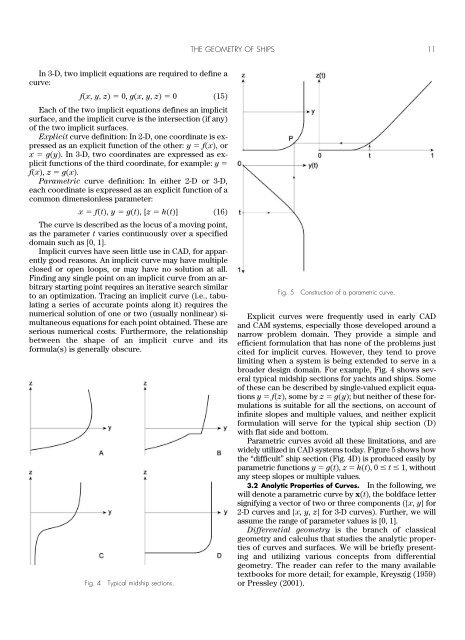The Geometry of Ships
You also want an ePaper? Increase the reach of your titles
YUMPU automatically turns print PDFs into web optimized ePapers that Google loves.
THE GEOMETRY OF SHIPS 11<br />
In 3-D, two implicit equations are required to define a<br />
curve:<br />
f(x, y, z) 0, g(x, y, z) 0 (15)<br />
Each <strong>of</strong> the two implicit equations defines an implicit<br />
surface, and the implicit curve is the intersection (if any)<br />
<strong>of</strong> the two implicit surfaces.<br />
Explicit curve definition: In 2-D, one coordinate is expressed<br />
as an explicit function <strong>of</strong> the other: y f(x), or<br />
x g(y). In 3-D, two coordinates are expressed as explicit<br />
functions <strong>of</strong> the third coordinate, for example: y <br />
f(x), z g(x).<br />
Parametric curve definition: In either 2-D or 3-D,<br />
each coordinate is expressed as an explicit function <strong>of</strong> a<br />
common dimensionless parameter:<br />
x f(t), y g(t), [z h(t)] (16)<br />
<strong>The</strong> curve is described as the locus <strong>of</strong> a moving point,<br />
as the parameter t varies continuously over a specified<br />
domain such as [0, 1].<br />
Implicit curves have seen little use in CAD, for apparently<br />
good reasons. An implicit curve may have multiple<br />
closed or open loops, or may have no solution at all.<br />
Finding any single point on an implicit curve from an arbitrary<br />
starting point requires an iterative search similar<br />
to an optimization. Tracing an implicit curve (i.e., tabulating<br />
a series <strong>of</strong> accurate points along it) requires the<br />
numerical solution <strong>of</strong> one or two (usually nonlinear) simultaneous<br />
equations for each point obtained. <strong>The</strong>se are<br />
serious numerical costs. Furthermore, the relationship<br />
between the shape <strong>of</strong> an implicit curve and its<br />
formula(s) is generally obscure.<br />
Fig. 4<br />
Typical midship sections.<br />
Fig. 5<br />
Construction <strong>of</strong> a parametric curve.<br />
Explicit curves were frequently used in early CAD<br />
and CAM systems, especially those developed around a<br />
narrow problem domain. <strong>The</strong>y provide a simple and<br />
efficient formulation that has none <strong>of</strong> the problems just<br />
cited for implicit curves. However, they tend to prove<br />
limiting when a system is being extended to serve in a<br />
broader design domain. For example, Fig. 4 shows several<br />
typical midship sections for yachts and ships. Some<br />
<strong>of</strong> these can be described by single-valued explicit equations<br />
y f(z), some by z g(y); but neither <strong>of</strong> these formulations<br />
is suitable for all the sections, on account <strong>of</strong><br />
infinite slopes and multiple values, and neither explicit<br />
formulation will serve for the typical ship section (D)<br />
with flat side and bottom.<br />
Parametric curves avoid all these limitations, and are<br />
widely utilized in CAD systems today. Figure 5 shows how<br />
the “difficult” ship section (Fig. 4D) is produced easily by<br />
parametric functions y g(t), z h(t), 0 t 1, without<br />
any steep slopes or multiple values.<br />
3.2 Analytic Properties <strong>of</strong> Curves. In the following, we<br />
will denote a parametric curve by x(t), the boldface letter<br />
signifying a vector <strong>of</strong> two or three components ({x, y} for<br />
2-D curves and {x, y, z} for 3-D curves). Further, we will<br />
assume the range <strong>of</strong> parameter values is [0, 1].<br />
Differential geometry is the branch <strong>of</strong> classical<br />
geometry and calculus that studies the analytic properties<br />
<strong>of</strong> curves and surfaces. We will be briefly presenting<br />
and utilizing various concepts from differential<br />
geometry. <strong>The</strong> reader can refer to the many available<br />
textbooks for more detail; for example, Kreyszig (1959)<br />
or Pressley (2001).



